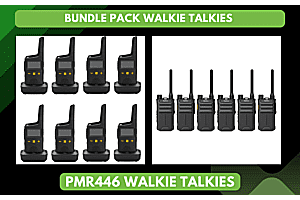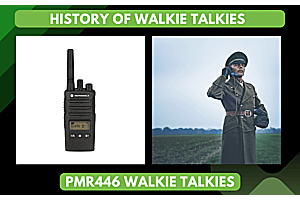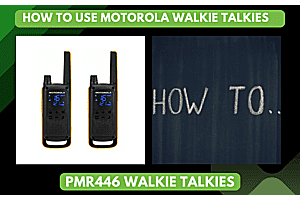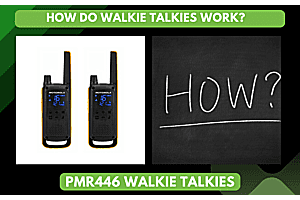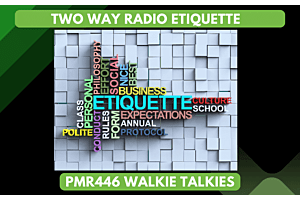
"Two-Way Radio Courtesy" is a set of established principles that ensure the responsible and effective use of walkie-talkies. These principles include ensuring clarity and brevity in speech, minimizing unnecessary noise, avoiding monopolizing the channel, and adhering to specific protocols or rules set by your organization or group. The primary objective of two-way radio courtesy is to facilitate clear communication, prevent miscommunications, and maximize the effective use of the radio channel.
Dos and Don'ts When Using Two-Way Radios
Here are some guidelines to follow:
- Speak clearly and keep it brief.
- Maintain a calm and respectful tone of voice.
- Use straightforward language and avoid jargon.
- Always listen before you speak.
- Monitor the channel before responding.
- Identify yourself and the person you're communicating with.
- Respond promptly to requests.
- Keep conversations short and focused.
- Avoid interrupting ongoing conversations.
- Use the appropriate channels for transmitting messages.
- Refrain from using offensive or inappropriate language.
- Never transmit sensitive or confidential information.
Two-Way Radio Usage Checklist
Being proficient with two-way radios is crucial. Here is a checklist to ensure your conversations are both effective and efficient:
- The standard radio language is English.
- Radios operate on a simplex system; you can't speak and listen simultaneously.
- Don't interrupt an ongoing conversation unless there's an emergency.
- If you have a callsign, only respond once you hear it.
- The channels are usually 'open,' so keep private information to a minimum.
- Ensure your radio is in good working condition and perform a radio check at the start of the day.
- Check that the battery is charged and the power is on.
- Make sure the volume is loud enough to hear incoming calls.
- Regularly perform radio checks to ensure you're still within signal range.
- Keep your conversations as concise, precise, and clear as possible.
- Only use abbreviations that are understood by your group.
Understanding Two-Way Radio Lingo
Here is a list of some commonly used two-way radio lingo:
- "Roger that" means "Message received and understood."
- "Stand by" means "I'm busy at the moment, I'll call you as soon as possible."
- "Affirmative" and "Negative" mean "Yes" and "No," respectively.
- "Come in" is a request for another user to acknowledge that they can hear you.
- "Go ahead" signals that you're ready to receive a message.
- "Say again" is a request for the last message to be repeated.
- "Disregard" asks the receiver to ignore the previous transmission.
- "Over" indicates that you've finished your part of the transmission and are ready for a reply.
- "Out" signifies that the conversation is finished, and no response is required or expected.
- "Radio check" is a request for feedback on your signal strength.
- "Do you copy?" is another way of asking, "Can you hear me?"
- "Loud and clear" affirms that your radio is working fine.
- "Mic check or Radio check" asks if your radio is working.
- "Say again or Go again" is a request to retransmit your message.
- "Read you loud and clear" indicates a good transmission signal and that the speaker can hear you well.
- "Wilco" is an abbreviation of "I will comply," signifying that the speaker will complete the requested task.
- "On it" signifies that you're in the process of doing what you've asked.
- "Eyes On" is an affirmation that you can see what is being discussed.
- "Break, break" is a call used to interrupt a transmission for urgent communication.
- "Emergency, emergency" is a distress call and should only be used when there is a direct threat to life and immediate help is needed.
- "Stand by" is a request for the receiver to wait for a short period, and the caller will get back to them.
- "Wait out" indicates that the waiting period might be longer than expected, but the caller will get back to the receiver as soon as possible.
- "What’s Your 20?" is a phrase used to ask, "Where are you?"
- "I spell" means that the speaker will spell out the next word using the phonetic alphabet.
Phonetic Alphabet for Two-Way Radios
Here's the phonetic alphabet used in two-way radio communication:
- A: Alpha
- B: Bravo
- C: Charlie
- D: Delta
- E: Echo
- F: Foxtrot
- G: Golf
- H: Hotel
- I: India
- J: Juliet
- K: Kilo
- L: Lima
- M: Mike
- N: November
- O: Oscar
- P: Papa
- Q: Quebec
- R: Romeo
- S: Sierra
- T: Tango
- U: Uniform
- V: Victor
- W: Whiskey
- X: X-ray
- Y: Yankee
- Z: Zulu
Initiating Radio Contact: The Right Way
Communication through two-way radios often starts by identifying the intended recipient and signaling your intent to begin a dialogue. You can do this in the following ways:
When you say "Come in, Bill," you're inquiring, "Are you there, Bill?" "Go ahead" is the cue that indicates your readiness to receive the message. Combining the two, "Go ahead, Bill" is your acknowledgment that "Bill" is attempting to contact you, and you're ready to listen. If you're initiating contact, like "Jane calling Bill," it signifies that you, Jane, wish to converse with Bill. Another way to initiate contact is "Bill, come in," which is essentially asking, "Are you there, Bill?"
Navigating a Conversation
Throughout your dialogue, you can utilise specific two-way radio phrases to communicate concisely and effectively:
- When you say "Affirmative," it means "Yes."
- "Copy" communicates that the message was understood.
- To cancel the preceding message, say "Disregard."
- If you can see the subject of discussion, indicate this with "Eyes on."
- "Negative" is the term for "No."
- If you're currently performing the task asked of you, respond with "On It."
- "Roger" or "Roger That" implies "Message understood."
- When you need a pause but intend to get back to the conversation, say "Stand By."
- To ask someone's location, use "What’s Your 20?"
Resolving Radio Check Issues
On occasion, you might encounter issues with your two-way radios. Here's how you handle these situations professionally:
- Ask "Do You Copy?" to inquire, "Can you hear me?"
- Respond with "Loud and Clear" to affirm that the radio is functioning as expected.
- To check the functionality of your radio, you can say "Mic Check" or "Radio Check."
- If you need the other party to repeat their message, request "Say Again" or "Go Again."
Concluding Your Conversation
Using specific two-way radio lingo to finish your conversation notifies all listeners that the dialogue has ended:
- Signify the end of a conversation with "Out." This implies that the conversation is over, and no answer is required or expected.
- "Over" is used to indicate that your part of the transmission has concluded, and you're ready for a reply.
